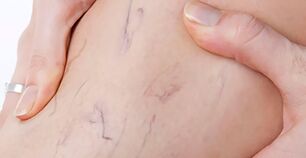
Small protruding veins aren't scary yet, but they make you think!
The initial stage of the disease is characterized by mild symptoms. However, a woman who is attentive to her health should not lose sight of such first signs of varicose veins:
- difficulty in the legs by the end of the day;
- swelling of the foot;
- appearance of pigmentation on the skin of the lower leg and thinning of the skin;
- limb numbness, common leg cramps;
- protrusion of veins above the skin surface;
- Appearance of the pattern of veins, the veins of the spider on the legs.
If, after returning from a work day, a woman finds her leg in a “deplorable state, ” you shouldn’t just blame the uncomfortable shoes or an extra “salty piece” at dinner. Swelling and heaviness in the legs is the first sign of blood stagnation in the blood vessels. Remember - venous diseases are difficult to treat. Early prevention and timely medical care can stop or significantly slow down the process of vein stretching. Treatment should be started as early as possible.
Varicose veins Grade 1
The main causes of varicose veins are pregnancy, overweight growth, prolonged physical activity, a sedentary lifestyle, and the genetic predisposition to such disease. The common people called varicose veins a "disease of stewardesses" because of the peculiarities of this profession and its long standing position. This degree of disease is the mildest.
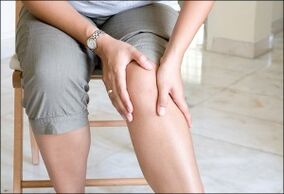
Classifies the disease according to various factors. One classification is made according to the stages of development of the disease:
- Reflections of the 1st degree or stage of compensation.
- Grade 2 varicose veins or stage of subcompensation.
- Grade 3 varicose veins or stage of deconcentration.
Different stages of varicose veins in the lower extremities have radically different treatments. You should not try to cope with the disease yourself. This can only harm and lead to catastrophic consequences. You better ask for help from a knowledgeable professional.
The first stage of varicose veins is characterized by nocturnal swelling and nocturnal cramps. Often people mistake these symptoms for normal fatigue. However, already at this stage, preventive measures should be taken, which include warming the legs to improve overall blood flow, light foot massage, regular swimming, cycling.
Varicose veins in the first stage can also manifest as cramps in the area of the calf, patients often complain of feeling stretched legs or burning muscles. This is increasingly accompanied by pain in the lower extremities.
Already at this stage, you can notice the visual nature of the varicose veins, which should alert you immediately:
- Mild cyanosis of the skin.
- The first spider veins appear in different parts of the body, more often on the legs.
- Visible curvature of blood vessels.
First-degree varicose veins are most often manifested by such external changes.

Another important factor in the manifestation of the first stage of varicose veins is the external state in which the person is. For example, in a hot environment, symptoms increase, swelling, pain, and cramps increase.
Treatment of first-degree varicose veins
Doctors sometimes recommend the continued use of venotonics, which are quite effective in the first stage of varicose veins. It must be said separately about massage: not all types of therapy are suitable for this disease. If the pain only intensifies after the procedures, the approach to choosing a massage complex should be changed.
You may want to arrange cool baths for your feet more often, which will soothe your muscles, relieve swelling, help reduce pain, and remove fatigue. But hot baths should be ruled out as they do not improve the condition of varicose limbs.
Doctors may recommend the following treatments for this stage of varicose veins:
- Sclerotherapy - a special medicine is injected with a needle directly into a vein. The effect of the drug is on the resorption of veins, strengthens the weak wall of blood vessels, blocks blood flow in the desired area.
- Ozone therapy - an action to strengthen blood vessels and absorb varicose stars.
All of the above options are quite effective. However, the maximum effect can only be achieved if all the recommendations that need to be followed after the procedures are applied.
Wearing special compression garments is most important. Such an element promotes the build-up of pressure in the veins, thereby preventing their further expansion.
Causes of the disease
There can be more than fifty reasons for a change in the venous system. People whose profession involves foot stress and sedentary activity are particularly susceptible to the disease: salespeople, hairdressers, programmers, accountants, drivers.
Scientists have done many years of research to identify the main factors that cause varicose changes:
- Hormonal changes in the body: pregnancy, menopause, transitional age;
- Any degree of obesity;
- Genetic predisposition. 70% of children with venous insufficiency develop varicose veins;
- Weak muscular system;
- Wearing uncomfortable underwear: socks with tight elastic straps, tight pants for men;
- Lack of activity and physical activity;
- The habit of one leg sitting on top of the other;
- Rare posture changes: prolonged, lying down, sedentary;
Chronic diseases: diabetes mellitus, high blood viscosity.
Eight out of ten varicose veins are female. The weaker one is not prone to venous pathologies during pregnancy, postpartum, due to forced hormonal disorders during menopause. The second important factor that makes women suffer from foot pain more often than men is the love of high heels.
Rules and Guidelines
In the initial stages of varicose veins, the patient is advised to follow the rules:
- Walk once or twice a day. You have to walk at a calm pace, stopping from time to time to rest.
- Wear comfortable shoes with heels higher than 3 cm. There should be no pull on the upper of the shoe, the laces are not tied as tightly as possible.
- Exercise twice a week in the gym. The loads are chosen individually by the doctor and the instructor.
Review your diet. High-sugar foods, fatty meats, flour products, and starchy vegetables are not foods. Most of the diet of varicose veins is steamed or cooked vegetables. Baked and spicy foods are not recommended.
- The feet should rest in the evening. The outflow of blood increases when you lift your leg and throw it on a tall pillow or the back of the couch.
- If the work involves a small amount of movement, it is recommended to lubricate the legs with refreshing gels or ointments containing heparin.
- Special compression garments or elastic bandages are used every day. Special underwear is selected by a doctor. A special feature of compression garments is the clamping function. The pressure on the body occurs with varying force, forcing the blood to circulate violently.
- Change position frequently. If you have to sit at work all the time, get up and sit down several times every 30 minutes. Exercise helps prevent varicose veins and hemorrhoids in the legs.
Manage different sections
In the initial stage, effective therapy may have the opposite effect in advanced pathology. The choice of treatment methods should be appropriate for the stages of varicose veins:
Compression jersey
It is used at all stages of the varicose vein, however, the degree of compression should vary significantly at different stages of the disease progression. In the initial stages of varicose veins, it is used for pre-compression purposes during standing and sitting work.
Compression can stop the development of varicose veins, but a phlebologist should be consulted before therapeutic use, as compression is dangerous because it exacerbates the problem of venous outflow. In the stage of compensation and subcompensation for edema and noticeable varicose veins, first and second compression class underwear is usually prescribed.
The third class of compression is used in severe venous insufficiency. If lymphedema occurs, use fourth-class underwear. The hospital jersey is worn for inpatient treatment.
Folk remedies
Traditional medicine helps treat varicose veins in the early stages. The following tools are widely used:
- Applying cabbage leaves
- compaction of potatoes, wormwood and garlic;
- chestnut tincture,
- Hop and nettle decoction.
However, the ease of use, accessibility, and softness of folk remedies are combined with low efficacy (compared to drugs), so enthusiasm for these methods is fraught with disease progression. Herbal medicines and compresses should be used after medical advice and should only be used as an adjunct to main treatment.
Hirudotherapy
Treatment with leeches is rarely indicated in advanced stages of varicose veins. Sometimes leeches are prescribed for thrombophlebitis.
Leeches can cause allergies and trophic ulcers that aggravate varicose veins. Currently, the method is being displaced by non-traumatic drugs that contain anticoagulant components.
Medications
Medication can help relieve symptoms. In the initial stages of varicose veins, tablets, capsules based on grape extract, chestnuts, which are biologically active additives, are effective.
Aid is prescribed in the compensation phase. Most ointments and gels contain heparin, which prevents blood clotting. The effect of ointments and gels is largely caused by the massage during application.
But in the decompensation phase, the use of such products can cause additional skin rashes. Relieving symptoms with medication is often temporary and does not cure the underlying cause.
Operations
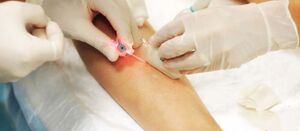
Laser coagulation and sclerotherapy are minimally invasive techniques to exclude veins from the bloodstream. It is used for the small diameter of dilated veins in the initial stages of varicose veins (when they get rid of poker, nets).
Endovascular laser coagulation of the vein
Phlebectomy
Surgical removal of veins is indicated in the third stage of the disease, accompanied by trophic ulcers and complications. In some cases, the varicose veins on the legs do not conform to the model presented in the stepwise classification. For example, the symptoms of the first stage may be completely absent: an image of subcompensation appears immediately.
Or, as the disease progresses, some signs of varicose veins do not add to the symptoms of the previous stage, but disappear. Therefore, in the early 21st century, in addition to a step-by-step approach, Russian phlebologists adopted the International Classification (CEAP), which takes into account the individual characteristics of the course of varicose veins and the effects of treatment when diagnosing the severity of the disease.
Symptoms
Symptoms of initial varicose veins do not cause people to get venous disease:
- feeling of heaviness in the legs;
- fatigue after walking.
They are prone to flat soles, unusual high heels, uncomfortable new shoes, lumbar osteochondrosis.
And only the visual perception of cyanotic dilated veins under the skin raises the suspicion of varicose veins.
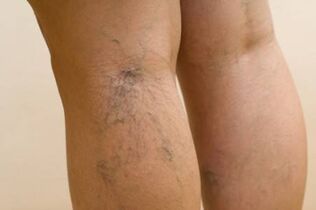
The vascular network, as the first sign of varicose veins, most often appears below the knee
Women seek medical attention when they notice unpleasant cosmetic defects in the form of reddish venous "spiders" on the legs, under the knees, on the skin of the thighs.
The "influx" of young women looking for treatment from a phlebologist specializing in venous diseases is usually related to the upcoming summer beach season, their appearance, not their health. They want to use the pills to restore the beauty of the skin on their feet.
Pregnant women pay more attention to their condition. In addition to the cosmetic changes, walking difficulties and increased fatigue in the evening are noticed.
The initial stage of the disease is indicated by the disappearance of clinical symptoms after lying down.
You can be sure to perform this experiment: after work, measure the volume of the lower leg at morning and evening level at the level of the ankle or calf muscles. If the difference is greater than 1 cm, there are signs of initial varicose veins.
Then appears:
- pain in the legs;
- swelling of the foot;
- feeling of fullness and heaviness in the legs;
- muscle cramps at night; The
- dilated veins will be like dense "snake" strips with dark skin.
These signs are undoubted manifestations of venous insufficiency and require treatment.
Main causes of varicose veins in women
Fatigue and edema may be the first manifestations of venous blood flow disorder
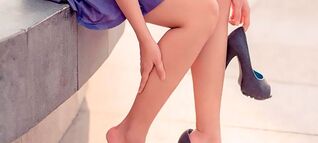
The sex hormone estrogen plays a special role in the development of varicose veins in women. Its effect leads to problems such as weight gain, depression, swelling, drowsiness, dry mucous membranes. This hormone increases the permeability of small blood vessels. The fluid easily leaves the bloodstream, the blood flows less. Excess fluid accumulates in the surrounding tissues. These factors contribute to the development of stagnation in the vessels of the lower extremities.
Reasons for estrogen increase in women:
- Imbalance in estrogen-progesterone production. It occurs in a woman due to a decrease in progesterone levels in the body;
- Chronic stress. During stress, the body produces cortisol, which in turn inhibits progesterone synthesis;
- Pregnancy. During pregnancy, the amount of estrogen in a woman’s body increases;
- Taking contraception. Varicose veins occur as a side effect of taking these medications;
- Liver disease because estrogen leaves the liver. Through malfunction, this hormone accumulates in the body;
- Age-related hormonal changes lead to sex hormone imbalances and estrogen predominance.
Special mention should be made of the causes of varicose veins, overweight and genetic predisposition to the disease. If overweight can and should be fought for the sake of health in general, then genetic predisposition cannot be prevented. As a result of these factors, varicose veins are significantly "younger" and are now often found in girls aged 16-20 years.
Complete liver function is important to maintain normal hormone levels. In addition to removing excess hormones, it is involved in the synthesis of substances - precursors of progesterone and estrogen. Improving your work requires minimizing physical activity, proper nutrition, and the entry of toxic substances into the body.
Varicose veins treatment with traditional medicine
Medication for varicose veins on the legs is the most effective method that is suitable for almost all patients. A wide range of medications allows you to choose the right medication for long-term treatment.
Therapeutic methods for leg varicose veins
Venotonics are among the most effective drugs for treating this disease. Venotonics are drugs that help increase the tone of veins and improve the outflow of blood from the veins.
These tablets can prevent the development of characteristic varicose veins and lumps.
Applying ointments
The best treatment for foot varicose veins is an integrated approach that includes medications in tablet form and the use of gels and ointments to externally treat problem areas.
Varicose ointment on the feet also helps to improve blood flow and prevent blood clots from forming.
We recommend that you use these funds only after consulting a doctor, who will also determine the duration of treatment and the procedure.
Do not self-medicate - this may further damage the patient's already poor condition.
Consequences of varicose veins.
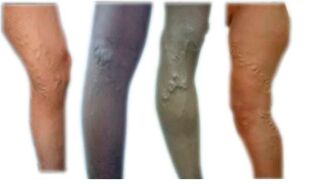
Varicose veins can lead to the development of trophic ulcers of the foot, thrombosis of varicose veins, thrombophlebitis, pulmonary embolism (immediate death) in the midst of apparent complete health.
Complicated sections of the varicose vein require surgery. Although women most often suffer from varicose veins, men are also affected by this disease, mainly for hereditary reasons.
A man under the age of 40 can appear on the operating table and heal varicose veins with radical measures - removing diseased veins.
Varicose veins are easy to remove.
In the groin, the surgeon makes an incision where the large saphenous vein affected by the vein flows into the femoral vein. The vein is exposed, ligated and excised, and a second incision is made at the ankle. Using a special metal probe placed in the lumen of the vessel, the entire enlarged vein is removed.
In the future, no relapses will be observed with the right operating technology. The blood supply to the foot is divided into other blood vessels and after 2 weeks everything is fully restored.
Risk factors predisposing to varicose veins.
- Connective tissue genetics and pathology;
- Female;
- Taking hormonal drugs: progesterone, estrogen;
- Pregnancy;
- Age: more common after 50;
- Overweight and physical inactivity;
- Prolonged vertical stay (standing work: hairdressers, salespeople, teachers, etc. );
- Obesity.
Symptoms and signs of varicose veins and chronic venous insufficiency.
| Varicose Veins Symptoms | External Signals |
| Painful pains | Telangiectasia |
| Heavy legs | Reticular veins |
| Fatigue | Varicose veins |
| Puffiness | Thrombophlebitis |
| Itchy skin | Hyperpigmentation |
| Feeling uncomfortable in the legs | Trauma knot bleeding |
| Cramps in the calf muscles | Ulcera |
Varicose vein treatment options.
The choice of treatment depends on the diameter and type of varicose veins
- Saphenous veins are varicose veins
- Medication
- Flexible compression and connection of legs
- Injection sclerotherapy
- Foam sclerotherapy
- Laser therapy
- Miniflebectomy
Dear women, you can wrap your varicose veins in long skirts and pants forever. If tablets and ointments are unable to normalize your feet, the only sure way to remove dilated veins remains. How and where, only after consultation with a specialist phlebologist. Veins can now be surgically treated without hospitalization, without anesthesia, without incisions, with high accuracy. You just have to take one step towards your health.
Detailed information on varicose veins, symptoms, disease prevention, special practices, treatment methods, and nutrition required can be found at ovaricoze. ru
How varicose veins appear in the early stages. Why it's dangerous
As a general rule, reticular varicose veins are painless. Therefore, the most common complaints of patients are cosmetic defects - visible reticular veins.
In rare cases, the appearance of such a reticulum is accompanied by a burning sensation or other change in the sensitivity of the skin.
These symptoms are accompanied by the first stage of the varicose vein:
- difficulty in the legs;
- increased foot fatigue;
- cramps in the muscles of the lower extremities, especially at night;
- itching at the site of appearance of the vascular network;
- Swelling of the legs and feet.
Treatment should be started in time to prevent disease progression
It is therefore important to consult a phlebologist, angiologist or vascular surgeon in good time to tell you what to do with such skin shapes. First, a specialist will perform an examination and prescribe the necessary additional tests to help identify the causes of the appearance of stars or mesh and to determine the extent of damage to the venous circulation.
To determine the extent and insufficiency of vascular lesions, do the following:
- complete blood count (shows whether the patient has anemia or thrombocytopenia);
- biochemical blood test (detects blood clotting disorders or liver and kidney function);
- general urine test (detects kidney problems);
- vascular ultrasound - duplex angioscanning (reveals the pathology of the vessel wall and blood flow disorders);
- Contrast X-ray phlebography (determines the localization of venous lesions and the extent of impairment of their functions).
If you do nothing after detecting the first signs of reticular varicose veins, you may:
- inflammatory association and development of thrombophlebitis in the superficial veins of the lower extremities;
- the transition of the pathological process from the superficial veins of the lower extremities to the deep ones;
- venous thrombosis. If thrombosis occurs in the venous vessels of the head, it is dangerous for cerebral hemorrhage and sinus thrombosis; The pulmonary arteries
- Thromboembolism is a fatal complication caused by thrombus detachment and blockage of the vessel wall lumen.
If you ignore the onset of initial reticular varicose veins and do not start treatment on time, the disease will progress. Then the development of complications becomes inevitable.
Prevention
Remember preventative measures. You need to spend time on sports to prevent this.
Avoid excessive physical exertion. Wear comfortable shoes with low heels (up to 4 cm). Remember that hot baths, baths and saunas have a detrimental effect on the health of the feet.
And following these simple guidelines will help prevent the disease from developing:
- try to get rid of bad habits - drinking and smoking negatively affect the condition of blood vessels;
- compression therapy - wear medical stockings, stockings and knee height;
- diet, weight control (overweight people are more likely to suffer from varicose veins), exclusion of fatty meats and poultry, giving up spicy and salty foods, be sure to include vegetables and fruits in your diet;
- massage - it is customary to have a light foot massage after a hard day's work, it helps to relax and improves the body's natural blood circulation.
Any disease is always easier to prevent than to cure. To be healthy!












































